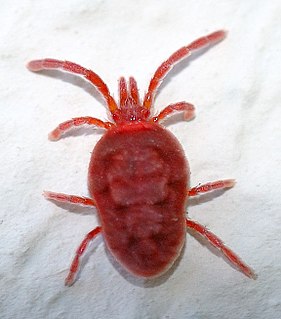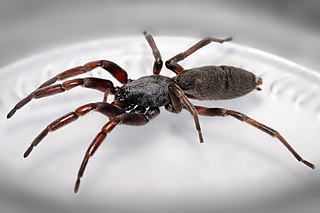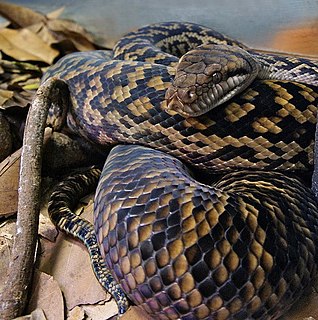Goodnight Scrub is a national park in Queensland, Australia, 274 km northwest of Brisbane. It is located in the locality of Good Night which is split between the Bundaberg Region and the North Burnett Region local government areas, but is predominantly in the Bundaberg Region part of the locality. The park covers an area of 66.7 square kilometres (25.8 sq mi) of land within the Burnett River water catchment and the South East Queensland bioregions. At the southern extent of the park is the Paradise Dam.
Nicoll Scrub is a national park in South East Queensland, Australia, 88 km southeast of Brisbane. It adjoins the Currumbin Valley Reserve and protects remnant rainforest vegetation. The park occupies the area between Mount Coolagang and Mount Boololagung of the McPherson Range.

Mites are small arachnids. Mites span two large orders of arachnids, the Acariformes and the Parasitiformes, which were historically grouped together in the subclass Acari, but genetic analysis does not show clear evidence of a close relationship.

Scrub typhus or bush typhus is a form of typhus caused by the intracellular parasite Orientia tsutsugamushi, a Gram-negative α-proteobacterium of family Rickettsiaceae first isolated and identified in 1930 in Japan.

The bridled nail-tail wallaby, also known as the bridled nail-tailed wallaby, bridled nailtail wallaby, bridled wallaby, merrin, and flashjack, is a vulnerable species of macropod. It is a small wallaby found in three isolated areas in Queensland, Australia, and whose population is declining. In early 2019 the total population of the species was estimated to be fewer than 500 mature individuals in the wild and 2285 in captivity.

Trombicula, known as chiggers, red bugs, scrub-itch mites, or berry bugs, are small arachnids in the Trombiculidae family. In their larval stage, they attach to various animals, including humans, and feed on skin, often causing itching and trombiculosis. These relatives of ticks are nearly microscopic, measuring 0.4 mm (0.01 in) and have a chrome-orange hue. A common species of harvest mite in North America is Trombicula alfreddugesi; in the UK, the most prevalent harvest mite is Trombicula autumnalis.

Trombicula alfreddugesi, also called Eutrombicula alfreddugesi, is a species in the genus Trombicula.
Acariasis is an infestation with mites.

Fleay's barred frog is a large species of frog restricted to small pockets of rainforest in northern New South Wales and south-eastern Queensland, Australia.

Lampona is a genus of South Pacific spiders in the family Lamponidae that was first described by Tamerlan Thorell in 1869. At least two species have a whitish tip to the abdomen and are known as "white-tailed spiders". Both hunt other spiders and have been introduced to New Zealand. The name is derived from the Middle English laumpe, meaning "light" or "fire".

Pyemotes herfsi, also known as the oak leaf gall mite or itch mite, is an ectoparasitic mite identified in Western Canada in 1923 and subsequently found in India, Asia, and the United States. The mite parasitizes a variety of insect hosts and bites humans, causing red, itchy, and painful wheals (welts). The mites are barely visible, measuring about 0.2–0.8 millimeters; their great reproductive potential, small size, and high capacity for dispersal by wind make them difficult to control or avoid.
Eutrombicula is a genus of mites in the family Trombiculidae. The species of this genus are found throughout North America, and Australia.

Trombiculidae ; commonly referred to in America as chiggers and in Britain as harvest mites, but also known as berry bugs, bush-mites, red bugs or scrub-itch mites, are a family of mites. Chiggers are often confused with jiggers – a type of flea. Several species of Trombiculidae in their larva stage bite their animal or human host and by embedding their mouthparts into the skin cause "intense irritation" or "a wheal, usually with severe itching and dermatitis".

The Trombidiformes are a large, diverse order of mites.

Tamopsis is a genus of tree trunk spiders that was first described by B. Baehr & M. Baehr in 1987. Like other members of the family, they may be called two-tailed spiders, referring to two elongated spinnerets. The name is derived from the genus Tama and the Ancient Greek ὄψις, meaning "resembling".

The Australian scrub python, or simply scrub python is a species of snake in the family Pythonidae. The species is indigenous to forests of northern Australia. It is one of the world's longest and largest snakes, and is the longest and largest in Australia. Recently, it has been reclassified to the genus Simalia alongside a few other former Morelia species, but scientific debate over this continues.
Pholcitrichocyclus is a genus of Australian cellar spiders that was first described by Ceccolini & Cianferoni, in 2022.
Eutrombicula samboni is a species of mite in the family Trombiculidae, found in South Australia.
Guntheria coorongensis is a species of mite in the family Trombiculidae, found from the tip of Cape York in Queensland to South Australia.









